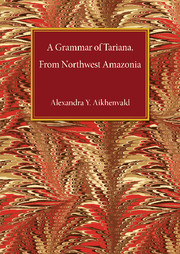Book contents
- Frontmatter
- Dedication
- Contents
- List of tables, schemes and diagrams
- Preface
- Acknowledgements
- Organisation and cross-referencing
- List of abbreviations
- Map
- 1 The language and its speakers
- 2 Phonology
- 3 Word classes
- 4 Nominal morphology and noun structure
- 5 Noun classes and classifiers
- 6 Possession
- 7 Case marking and grammatical relations
- 8 Number
- 9 Further nominal categories
- 10 Derivation and compounding
- 11 Closed word classes
- 12 Verb classes and predicate structure
- 13 Valency changing and argument rearranging mechanisms
- 14 Tense and evidentiality
- 15 Aspect, Aktionsart and degree
- 16 Mood and modality
- 17 Negation
- 18 Serial verb constructions and verb compounding
- 19 Complex predicates
- 20 Participles and nominalisations
- 21 Clause types and other syntactic issues
- 22 Subordinate clauses and clause linking
- 23 Relative clauses
- 24 Complement clauses
- 25 Discourse organisation
- 26 Issues in etymology and semantics
- Appendix. The main features of the Tariana dialects
- Texts
- Vocabulary
- References
- Index of authors, languages and subjects
Appendix. The main features of the Tariana dialects
Published online by Cambridge University Press: 05 August 2013
- Frontmatter
- Dedication
- Contents
- List of tables, schemes and diagrams
- Preface
- Acknowledgements
- Organisation and cross-referencing
- List of abbreviations
- Map
- 1 The language and its speakers
- 2 Phonology
- 3 Word classes
- 4 Nominal morphology and noun structure
- 5 Noun classes and classifiers
- 6 Possession
- 7 Case marking and grammatical relations
- 8 Number
- 9 Further nominal categories
- 10 Derivation and compounding
- 11 Closed word classes
- 12 Verb classes and predicate structure
- 13 Valency changing and argument rearranging mechanisms
- 14 Tense and evidentiality
- 15 Aspect, Aktionsart and degree
- 16 Mood and modality
- 17 Negation
- 18 Serial verb constructions and verb compounding
- 19 Complex predicates
- 20 Participles and nominalisations
- 21 Clause types and other syntactic issues
- 22 Subordinate clauses and clause linking
- 23 Relative clauses
- 24 Complement clauses
- 25 Discourse organisation
- 26 Issues in etymology and semantics
- Appendix. The main features of the Tariana dialects
- Texts
- Vocabulary
- References
- Index of authors, languages and subjects
Summary
This grammar focuses on the Santa Rosa dialect of Tariana. Here I discuss the features characteristic of other dialects. There are strong indications, however, that in the past each subgroup (see the list in §1.4) spoke a separate dialect, and that various dialects represented a dialect chain. A superficial comparison of the surviving or documented dialects shows that in the past Tariana must have been a dialect continuum. The differences between the extremes of this continuum could be comparable to those between French and Portuguese within the Romance family. The exact dialectal differences between the groups are now difficult to determine, since the language has been lost by most groups. In §1 and §2 I discuss the dialects which are still spoken; other, now extinct, dialects are considered in §3.
The Periquitos dialect
The two Wamiarikune groups – that of Santa Rosa and that of Periquitos – display minor phonological and morphological differences. The two varieties are mutually intelligible. The Wamiarikune Tariana-speaking group of Periquitos (the Muniz family) are considered to be classificatory elder brothers to the Tariana of Santa Rosa (the Brito family). They appear to share most myths and stories, but employ a slightly different set of sacred names. The Wamiarikune dialect must have undergone some changes during the last fifty years. Maria Sanchez, Candido's wife, speaks the Tariana of Wamiarikune the way her mother, an ethnic Tariana, ‘taught’ her.
- Type
- Chapter
- Information
- A Grammar of Tariana, from Northwest Amazonia , pp. 620 - 629Publisher: Cambridge University PressPrint publication year: 2003



